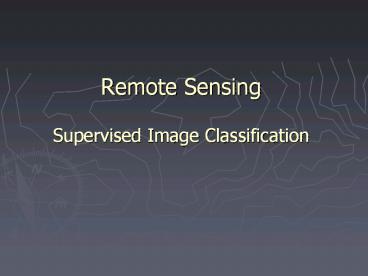Remote%20Sensing%20Supervised%20Image%20Classification - PowerPoint PPT Presentation
Title:
Remote%20Sensing%20Supervised%20Image%20Classification
Description:
Title: Questions and Answers Author: Ling Bian Last modified by: UB Created Date: 7/9/2001 1:55:56 PM Document presentation format: On-screen Show (4:3) – PowerPoint PPT presentation
Number of Views:268
Avg rating:3.0/5.0
Title: Remote%20Sensing%20Supervised%20Image%20Classification
1
Remote SensingSupervised Image Classification
2
Supervised Image Classification
- An image classification procedure that requires
interaction with the analyst
3
(No Transcript)
4
(No Transcript)
5
1. General Procedures
- Training stage - The analyst identifies the
representative training areas (training set) and
develops summary statistics for each category - Classification stage - Each pixel is
categorized into a land cover class - Output stage - The classified image is
presented in GIS or other forms
6
(No Transcript)
7
(No Transcript)
8
http//aria.arizona.edu/slg/Vandriel.ppt
9
Training
10
(No Transcript)
11
Classifiers
- Minimum distance classifier
- Parallelepiped classifier
- Gaussian maximum likelihood classifier
12
2. Minimum Distance Classifier
- Calculates mean of the spectral values for the
training set in each band and for each category - Measures the distance from a pixel of unknown
identify to the mean of each category - Assigns the pixel to the category with the
shortest distance - Assigns a pixel as "unknown" if the pixel is
beyond the distances defined by the analyst
13
(40,60)
0,0
14
(No Transcript)
15
Minimum Distance Classifier ..
- Advantage computationally simple and fast
- Disadvantage insensitive to differences in
variance among categories
16
3. Parallelepiped Classifier
- Forms a decision region by the maximum and
minimum values of the training set in each band
and for each category - Assigns a pixel to the category where the pixel
falls in - Assigns a pixel as "unknown" if it falls outside
of all regions
17
(No Transcript)
18
Parallelepiped Classifier ..
- Advantage computationally simple and fast
- takes differences in variance into account
- Disadvantage performs poorly when the regions
overlap because of high correlation between
categories (high covariance)
19
?
20
(No Transcript)
21
4. Gaussian Maximum likelihood Classifier
- Assumes the (probability density function)
distribution of the training set is normal - Describes the membership of a pixel in a
category by probability terms - The probability is computed based on probability
density function for each category
22
(No Transcript)
23
Gaussian Maximum likelihood Classifier ..
- A pixel may occur in several categories but with
different probabilities - Assign a pixel to the category with the highest
probability
24
(No Transcript)
25
Gaussian Maximum likelihood Classifier ..
- Advantage takes into account the distance,
variance, and covariance - Disadvantage computationally intensive
26
5. Training
- Collect a set of statistics that describe the
spectral response pattern for each land cover
type to be classified - Select several spectral classes representative
of each land cover category - Avoid pixels between land cover types
27
Training ..
28
Training ..
- A minimum of n1 pixels must be selected
(nnumber of bands) - More pixels will improve statistical
representation, 10n or 100n are common - Spatially dispersed training areas throughout
the scene better represent the variation of the
cover types
29
6. Training Set Refinement
- Graphic representation
- Quantitative expression
- Self-classification
30
Training Set Refinement ..
- Graphic representation
- It is necessary to display histograms of
training sets to check for normality and purity - Coincident spectral plot with 2 std dev from the
mean is useful to check for category overlap - 2-D scatter gram is also useful for refinement
31
(No Transcript)
32
Training Set Refinement ..
- Quantitative expression divergence matrix,
higher values indicate greater separability
33
(No Transcript)
34
Training Set Refinement ..
- Training set self-classification
- - interactive preliminary classification
- - use simple and fast classifier to classify
the entire scene - Representative sub-scene classification
35
1. Post-Classification Smoothing
- Majority filter use a moving window to filter
out the salt and pepper minority pixels - By assigning the majority category of the window
to the center pixel of the window
36
Readings
- Chapter 7
37
(No Transcript)
38
(No Transcript)

